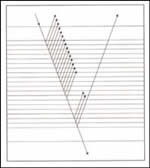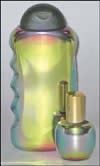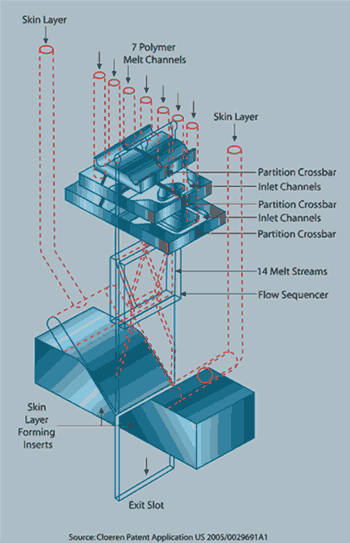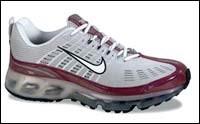Microlayer Films: New Uses for Hundreds of Layers
Early microlayer films gave an iridescent shimmer to decorative packaging. The newest films with hundreds and even thousands of layers are designed for gas barrier, uv blocking, electronic displays, and high-strength window-glass laminates. As applications grow, more processors want in on the action.
Microlayer films are cast coextrusions with anywhere from 30 to 1000 layers, each layer from 0.02 to 5 mi crons thick. Not some fu tu ristic fantasy, these films are very real commercial products. The seemingly improbable feat of assembling all those layers is accomplished in a coextrusion feedblock by splitting and stacking a small number of input melt streams—
sometimes no more than two or three.
For three decades, microlayer films were made commercially by one firm for mirror-like or iridescent films used in gift wrap, ribbons, and other decorative applications. But in the past three to five years, dozens of new types of microlayer films have been commercialized by a half-dozen producers in a growing spectrum of applications from window-glass laminates and computer screens to hydraulics and footwear. At least three more processors are developing additional applications that aren’t yet commercial.
Microlayer films divide broadly into optical films that selectively filter or reflect particular wavelengths of light and barrier films with remarkable strength and flexibility. Some products combine light control and high strength. Optical films typically use fewer polymers, and more and thinner layers—from 100 to 1000 or more. Barrier films use fewer, thicker microlayers and more polymers, typically using seven to 11 extruders. Microlayer barrier films may also be laminated onto other webs—for example, soft TPU film.
All in the feedblock
There are two basic commercial feedblock technologies for microlayer films. The first was invented by Dow Chemical Co. in the 1960s, the second by die maker Cloeren Inc. in the early 1990s. More recently, Black Clawson (now part of Davis-Standard) and Extrusion Dies Industries (EDI) have also developed their own microlayer feedblocks, but so far only for R&D uses.
In addition, Clemson University’s new melt-folding technology, called “chaotic advection,” can create a repeatable stack of up to 1000 semi-continuous microlayers (see “Learn More” box) in a feedblock-like device called a SmartBlender. There is also ongoing microlayer research at Case Western Reserve University, Cleveland, and the Univ. of Minnesota, Minneapolis.
Dow’s feedblock technology, termed an interfacial generator or layer multiplier, splits and stacks microlayers. Layer multiplication is produced sequentially, and Dow can multiply a given layer stack almost indefinitely. Dow’s newer versions are said to produce more uniform layers by means of flow-path equalization.
Cloeren’s microlayer feedblocks split the melt flow, then realign the flows into packets, each typically containing 17 or 34 continuous layers. Packets are then stacked together. Cloeren has made up to 452 layers this way.
Dow’s original microlayer technology was invented by Walter Schrenk and colleagues, who created a large patent portfolio for Dow. But Dow did not directly commercialize its patented technology. Dow did sell a couple of licenses to its microlayer cast film technology, one to Mearl Corp. (now part of Engelhard Corp., Peekskill, N.Y.) in 1976 and one to 3M Corp., St. Paul, Minn., in 1995. (Schrenk et al also patented blown film with hundreds of layers, but it is not believed to have ever been commercialized.)
Dow is still active in microlayer feedblock developments. It has a new license agreement with EDI to offer Dow’s third-generation technology for microlayer packaging. EDI says it has already signed up one licensee.
EDI has a three-extruder microlayer film lab line set up for trials of up to 48 layers. It has run trials with up to 32 layers so far. EDI is exploring potential for material cost savings by using less expensive materials in combinations that perform like a more expensive material—for example, alternating PETs with different I.V.
Cloeren developed an approach different from Dow’s layer-stacking technology. A recent Cloeren patent application (U.S. 2005/0029691 A1, Feb. 2005) describes a method for splitting melt streams, creating a microlayer structure in the feedblock. Each stream can be split multiple times. The multiple streams are then aligned vertically and thicker surface layers are brought together around the microlayer composite core at the end of the feedblock. The whole package is then extruded through a conventional cast film die.
Cloeren has sold more than half a dozen microlayer feedblocks for films 2.5 to 3.5 meters wide. Three units went to companies producing EVOH-based films that reportedly have more than twice the gas barrier of nine-layer blown film containing nylon or EVOH. The big advantage isn’t higher barrier alone, but increased strength and flexibility.
Cloeren has retrofitted existing lines to produce microlayers. Retrofitting isn’t always possible because these lines usually extrude downward through a vertical feedblock. Microlayer feedblocks are longer than conventional ones, so the extruders are typically placed up on a mezzanine to get the required “drop height.”
At the NPE 2001 show, Black Clawson displayed a newly developed microlayer feedblock. It has sold only one 14-layer feedblock (built by Cloeren) to an unidentified customer.
Microlayer optical films
Three companies now make decorative iridescent microlayer films that were for a long time the only use of this versatile technology. Engelhard (which purchased Mearl Corp.) has produced a wide range of decorative films with 113 or 226 microlayers for gift wrap, labels, ribbons, textiles, wall coverings and other applications since 1976. Newer products include iridescent shrink sleeves for labels. Teijin DuPont in Japan has made decorative films with up to 200 layers since about 2001. Rainbow Package Industrial Co. in Taiwan also makes iridescent microlayer film.
Engelhard and Teijin Du Pont both use Cloeren feedblocks. Rainbow is believed to use technology similar to that in Dow’s first-generation microlayer patents, which have expired.
The original decorative films alternate two materials in a stack of layers of equal thickness, with a third extruder providing protective surface layers. (All microlayer films require a protective coating to get through the die without having the delicate microlayers destroyed by shear.)
3M also briefly produced decorative films, but quit that market in favor of microlayer light-control films. After 3M bought a number of Dow’s microlayer patents, 3M researcher Andrew Ouderkirk made a breakthrough discovery that different thicknesses of adjacent microlayers affect the way light reflects off the interfaces between them. In fact, 3M’s most significant microlayer patents apply to manipulating layer thickness to control specific wavelengths of light. This opened the way for a lot of entirely new microlayer film structures. 3M now makes over a dozen different optical films, trade-named Vikuiti Films, some of them biaxially oriented to enhance their toughness.
These products include reflective polarizers, known as brightness-enhancement filters, which are applied to electronic screens for laptops, cell phones, camcorders, rear-projection televisions, and air-traffic control systems to make LCDs brighter, more uniformly lit, and easier to read.
One example is a 900-layer brightness-enhancing film for the screens of Palm hand-held computers. Another is Mirror Film VM2000, used in “solar light pipes” to transport visible light over long distances from rooftops into lower rooms to save energy.
Window glass is another big commercial market for 3M microlayer optical films. Scotchshield Ultra Safety and Security window films make windows nearly unbreakable. They also block 99% of uv light in architectural and automotive glazing to save energy and prevent fading.
3M calls Scotchshield Ultra “the world’s strongest film,” capable of foiling burglaries. Ultra films are made of multiples of a 12-microlayer stack that is biaxially oriented. They come in three levels of toughness, which have 12, 24, and 36 microlayers and pass impact tests at 150, 400, and 600 ft-lb respectively.
Bending laws of physics
Controlling light waves as they pass through or bounce off of hundreds or thousands of layer interfaces is defined by the refractive index of the adjacent polymers. The larger the difference in refractive indices of adjacent polymer layers, the brighter the reflection off their interface. The reflection is also brighter with more layers in the stack.
Decorative films alternate layers of two polymers, typically a polyester like PET with a refractive index of 1.8 and an acrylic like PMMA with a refractive index of 1.5. The reflected-color effect varies as the viewing angle onto the film changes.
Birefringence is caused by the difference in refractive index between polymers at different viewing angles. Birefringent polymer pairs in microlayer films typically leak light when they are tilted and reflect only within a specific range of viewing angles. From all other angles, the interface appears transparent.
3M discovered that different layer thicknesses in a stack could create highly sophisticated patterns of reflections, capable of passing some waves of light through while stopping other wavelengths, and creating structures that reflect equally well from any viewing angle.
3M developed material pairs at different adjacent layer thicknesses that create an almost perfect mirror to reflect at all angles. 3M also discovered that if the refractive index in the horizontal or y direction for layer 1 equals the refractive index in the vertical or z direction for layer 2 (and vice versa), the film shows constant reflectivity from all viewing angles.
Microlayer barrier films
3M wasn’t the only one to carry on Dow’s patent legacy. Former Dow researchers helped take microlayer technology into new markets. Nike, for example, explored and patented elastomeric microlayer barrier films for cushioning bladders in athletic shoes (U.S. Pa tent 6,082,025 in 2000) designed to contain pressurized nitrogen. Nike’s newest shoe line, Air Max 360, is the first to sport an entire air-filled sole, which probably wouldn’t be possible without the new microlayer bladders.
Nike’s microlayer bladders alternate layers of EVOH and a TPE or combination of TPEs. Nike’s patents describe bladders with up to 1000 microlayers and layer thicknesses as thin as 0.01 micron. Nike makes about a dozen different cast microlayer barrier films on three cast film lines having up to five extruders. Most of these films have 30 to 100 microlayers that increase the bladder’s physical strength and flexibility as well as its barrier properties. One structure is a 2-meter-wide film containing around 75 microlayers, about half of them EVOH.
Nike’s films were first developed at Nike’s Tetra Plastics subsidiary in Chesterfield, Mo., in 1998 and are now made at Nike’s in-house manufacturing (IHM) plant in St. Charles, Mo., which makes films for both Nike and outside customers. The St. Charles plant also makes microlayer films for non-shoe applications, which Nike has patented.
Microlayer films have particular advantages for barrier films. “Barrier is improved because the layers physically increase the time to equili brium saturation of penetrants,” says Gary Oliver, senior corporate scientist, who is also a Dow alumnus. Many super-thin layers also make film stronger and more flexible. “The mutual reinforcement of adjacent layers improves EVOH’s resistance to cracking and pinholing,” notes Oliver.
In addition, some sources say microlayers can improve layer adhesion, so that in some structures a tie layer is no longer needed between EVOH and polyolefins.
Cloeren built a feedblock for a 450-layer EVOH barrier film that was commercialized in 2003. Cast barrier microlayer films are coextruded using up to 11 extruders.
Battenfeld Gloucester Engineering is now building a line with nine extruders to produce 17-layer barrier film, which can be expanded with a Cloeren feedblock to 34 layers. It will go into operation in the first half of this year to make high-barrier retort pouches.
Related Content
Troubleshooting Screw and Barrel Wear in Extrusion
Extruder screws and barrels will wear over time. If you are seeing a reduction in specific rate and higher discharge temperatures, wear is the likely culprit.
Read MoreHow to Select the Right Cooling Stack for Sheet
First, remember there is no universal cooling-roll stack. And be sure to take into account the specific heat of the polymer you are processing.
Read MoreHow Screw Design Can Boost Output of Single-Screw Extruders
Optimizing screw design for a lower discharge temperature has been shown to significantly increase output rate.
Read MoreWhat to Know About Your Materials When Choosing a Feeder
Feeder performance is crucial to operating extrusion and compounding lines. And consistent, reliable feeding depends in large part on selecting a feeder compatible with the materials and additives you intend to process. Follow these tips to analyze your feeder requirements.
Read MoreRead Next
Lead the Conversation, Change the Conversation
Coverage of single-use plastics can be both misleading and demoralizing. Here are 10 tips for changing the perception of the plastics industry at your company and in your community.
Read MoreBeyond Prototypes: 8 Ways the Plastics Industry Is Using 3D Printing
Plastics processors are finding applications for 3D printing around the plant and across the supply chain. Here are 8 examples to look for at NPE2024.
Read MorePeople 4.0 – How to Get Buy-In from Your Staff for Industry 4.0 Systems
Implementing a production monitoring system as the foundation of a ‘smart factory’ is about integrating people with new technology as much as it is about integrating machines and computers. Here are tips from a company that has gone through the process.
Read More






















